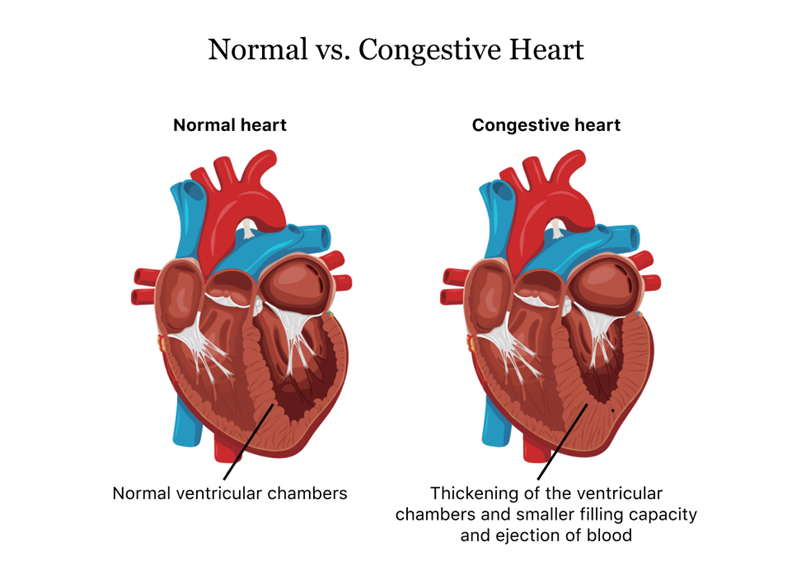A nurse is assessing a client with congestive heart failure (CHF). Which assessment tool will provide a reliable measure of fluid retention for this client?
Cardiac monitoring
Daily weight measurement
Blood pressure monitoring
Urine output measurement
The Correct Answer is B
Choice A Reason:
Cardiac monitoring involves the continuous observation of the heart’s electrical activity, typically using an electrocardiogram (ECG). While cardiac monitoring is essential for detecting arrhythmias and other cardiac events, it does not directly measure fluid retention. Fluid retention in CHF patients can lead to symptoms such as edema and weight gain, which are not directly assessed through cardiac monitoring.
Choice B Reason:
Daily weight measurement is a reliable and practical method for assessing fluid retention in clients with congestive heart failure. Fluid retention leads to an increase in body weight, and monitoring daily weight changes can help detect fluid accumulation early. A sudden weight gain of more than 2-3 pounds in a day or 5 pounds in a week is a significant indicator of fluid retention and worsening heart failure. This method is non-invasive, easy to perform, and provides valuable information for managing CHF.

Choice C Reason:
Blood pressure monitoring is crucial for managing clients with CHF, as hypertension can exacerbate heart failure. However, blood pressure readings alone do not provide a direct measure of fluid retention. While fluid overload can affect blood pressure, it is not a specific or sensitive indicator of fluid status. Blood pressure monitoring should be used in conjunction with other assessment tools to manage CHF effectively.
Choice D Reason:
Urine output measurement is an important parameter for assessing kidney function and fluid balance. In clients with CHF, reduced urine output can indicate worsening heart failure and fluid retention. However, urine output alone may not provide a complete picture of fluid status, especially if the client is on diuretic therapy. Daily weight measurement remains a more direct and reliable method for assessing fluid retention in CHF patients.
Nursing Test Bank
Naxlex Comprehensive Predictor Exams
Related Questions
Correct Answer is A
Explanation
Choice A Reason:
Mobilizes secretions is correct. Expectorants work by thinning and loosening the mucus in the airways, making it easier to cough up and expel. This helps clear the respiratory tract of mucus and other secretions, making the cough more productive.
Choice B Reason:
Suppresses the urge to cough is incorrect. This describes the action of antitussives, not expectorants. Antitussives work by suppressing the cough reflex, which is different from the mechanism of expectorants.
Choice C Reason:
Reduces inflammation is incorrect. While reducing inflammation can help with respiratory symptoms, it is not the primary mechanism of action for expectorants. Anti-inflammatory medications are used to reduce inflammation.
Choice D Reason:
Dries mucous membranes is incorrect. Drying mucous membranes is typically the action of antihistamines, not expectorants. Expectorants aim to increase the moisture in mucus to make it less sticky and easier to expel.
Correct Answer is C
Explanation
Choice A Reason:
The client has full range of motion in her wrist does not necessarily indicate a need to loosen the restraints. Full range of motion suggests that the restraints are not too tight and are allowing for some movement. However, it is important to regularly assess the client’s circulation, skin integrity, and comfort to ensure the restraints are not causing harm.
Choice B Reason:
The client is attempting to remove the restraint is a common behavior in clients who are restrained, especially if they are confused or agitated. While this behavior warrants close monitoring and possibly re-evaluating the need for restraints, it does not necessarily indicate that the restraints need to be loosened. The nurse should assess the client’s overall condition and consider alternative methods to ensure safety.
Choice C Reason:
The client has cyanotic digits is a critical finding that indicates impaired circulation. Cyanosis, or a bluish discoloration of the skin, occurs when there is a lack of oxygen in the blood. This can be a sign that the restraints are too tight and are restricting blood flow to the extremities. In this case, the nurse should immediately loosen the restraints to restore proper circulation and prevent further complications.
Choice D Reason:
The client denies discomfort is a positive finding, indicating that the client is not experiencing pain or distress from the restraints. However, the absence of discomfort does not rule out other potential issues such as impaired circulation or skin breakdown. Regular assessments are necessary to ensure the restraints are being used safely and effectively.
Whether you are a student looking to ace your exams or a practicing nurse seeking to enhance your expertise , our nursing education contents will empower you with the confidence and competence to make a difference in the lives of patients and become a respected leader in the healthcare field.
Visit Naxlex, invest in your future and unlock endless possibilities with our unparalleled nursing education contents today
Report Wrong Answer on the Current Question
Do you disagree with the answer? If yes, what is your expected answer? Explain.
Kindly be descriptive with the issue you are facing.
